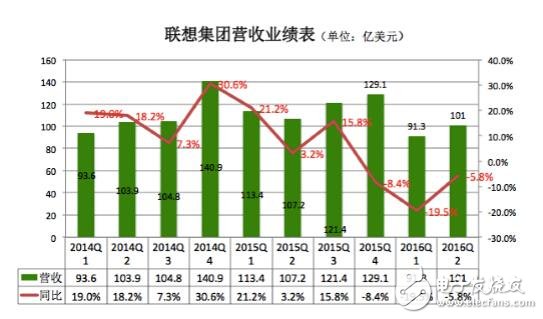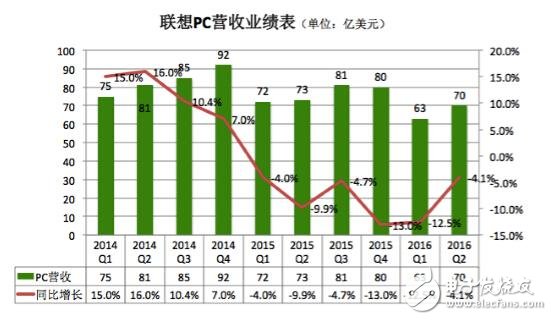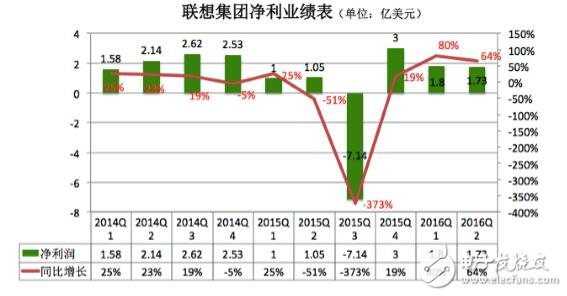Lenovo Group released its financial report for the first quarter ended June 30, 2016 (the second quarter of the natural season in 2016). Lenovo Group’s second quarter revenue was $10.1 billion, down 6% year-on-year. Since the fourth quarter of 2015, Lenovo has experienced negative revenue growth for three consecutive quarters. In the second quarter, Lenovo Group's net profit rose 64% year-on-year to US$173 million.

At present, Lenovo Group divides its business into four major segments: Personal Computer and Intelligent Device Group (hereinafter referred to as "Lenovo PC"), Mobile Business Group, Data Center Business Group and Lenovo Venture Capital Group and others. Among them, Lenovo PC accounted for nearly 70% of total revenue, Lenovo Mobile accounted for nearly 20% of total revenue, all other businesses accounted for about 10% of Lenovo's total revenue.
The Data Center Business Group (DCG) was established in June this year on the basis of the original enterprise-level business group, and Lenovo hopes to expand its advantages in the field of IT solutions. The group's revenue accounted for about 10% of Lenovo's overall revenue, but the growth was slow. In the second quarter of this year, Lenovo's data center business revenue increased by 1% year-on-year to US$1.086 billion. The business continued to perform strongly in China, with revenue up 14% year-on-year. However, competition in markets outside China is still fierce, with a year-on-year decline.
Lenovo Ventures Group invested $500 million in investment portfolio by Lenovo Group, which will invest in four major areas, namely cloud computing + big data, artificial intelligence + robotics, Internet + and consumer upgrades. Due to its long investment cycle, the revenue that can be contributed in the short term is limited.
PC and mobile phone business both enter the trough
The worst news for Lenovo is that the two most important businesses have both entered the downturn. Among them, although the Lenovo PC market share did not fall sharply, firmly occupy the top spot of the global PC, but due to the continuous decline in the global PC market, Lenovo PC was not spared. Since the second quarter of 2015, Lenovo PC revenue has experienced negative growth for six consecutive quarters.

Lenovo's second-largest business, Lenovo Mobile, has also entered a trough. Since the fourth quarter of 2015, Lenovo Mobile has experienced negative growth for three consecutive quarters.
In the fourth quarter of 2014, Lenovo Mobile Business Group's revenue was $3.4 billion, a year-on-year increase of 109%. It seems that the performance is very eye-catching. However, it should be pointed out that the above-mentioned growth is mainly due to the fact that the Motorola battalion has not been included in Lenovo's financial report in the same period of last year. From the fourth quarter of 2014, Motorola's revenue was officially included in the Lenovo Mobile Business Group. Motorola's sales exceeded 10 million units in the quarter, bringing $1.9 billion in revenue to the mobile business group.
Interestingly, Lenovo Mobile’s revenue for the second quarter of this year was $1.7 billion, which was close to $1.6 billion compared to the same period two years ago. Considering that Motorola has not been included in Lenovo's earnings two years ago, the revenue after two years includes Motorola. At least from the perspective of revenue, Lenovo’s acquisition of Motorola has not revitalized its mobile phone business.
When Lenovo integrated Motorola's integration, it said that it would turn a profit in 4-6 quarters. According to the second quarter 2016 financial report, Lenovo Mobile Business Group's total pre-tax loss was $206 million, and the pre-tax loss rate. It is 12.1%.
However, although Lenovo's revenue has been falling year on year, but the cost has been effectively controlled, the net profit has not dropped significantly, but has achieved a certain degree of annual growth.
On August 13, 2015, Lenovo Group disclosed in the second quarter earnings report that it will carry out layoffs and reorganizations on a global scale and carry out a $1.3 billion cost saving plan. This led Lenovo to generate a one-time fee of $923 million in the third quarter of 2015, including restructuring costs of $599 million and clearing of smartphone inventory expenses by $324 million. Lenovo Group lost $714 million in the quarter, which is also the Lenovo Group’s financial crisis. The first loss in six years since.
It has paid a huge cost, but the layoffs and restructuring have saved Lenovo's profitability to a certain extent. From the fourth quarter of 2015, Lenovo Group began to turn losses into profit, and its net profit remained at a relatively stable level.

Overseas market or Lenovo mobile life straw
For Lenovo, PC business accounts for about 70% of its overall revenue. However, the global PC industry has entered the most difficult period, and shipments have fallen for at least eight consecutive quarters. It is unlikely that the company will turn around and rely on the global PC industry to return to life.
Lenovo's mobile business accounted for about 20% of Lenovo's overall revenue. Last year, Lenovo Mobile's global mobile phone shipments reached 66 million units, compared with Chinese mobile phone manufacturers, second only to Huawei (108 million units shipped) and TCL (80 million units). Mainly sold overseas, half of the sales rely on functional machines) and Xiaomi (more than 70 million units).
In the second quarter of this year, Lenovo Mobile's global mobile phone shipments fell 13% year-on-year to 11.2 million units. Lenovo said that the decline in mobile phone sales was mainly due to product transformation in the Americas and macroeconomic challenges in Latin America.
However, most of Lenovo Mobile's mobile phones are sold overseas. Last year, Lenovo Mobile shipped 51 million mobile phones overseas. In China's mobile phone market, Lenovo sold only 15 million units last year. This data is not as good as Huawei, Xiaomi, OPPO, vivi and Meizu in the same period.
After each Lenovo earnings report, the outside world often compares Huawei with it, but in fact, Lenovo starts with “trade and industry technology†(trade first), while Huawei uses “technical industry and trade†(technology first). Starting from the beginning, the two have taken different paths from the beginning, and the comparability is not strong. However, the two have indeed had a lot of commonality in the mobile phone market, that is, they are highly dependent on operators.
The emergence of Lei Jun and his Xiaomi has caused extreme panic among other Chinese mobile phone manufacturers. Many manufacturers, including Huawei, have followed the model of Xiaomi and began to dilute the operator channel. Huawei also cut off the low-end mobile phone business and turned to high-end Huawei mobile phones, while the low-end thousand yuan machine market is dominated by glory brands.
Lenovo is awakened later than Huawei. Until 2015, some mobile phone businesses still rely on operators, but with the subsidies of operators falling, Lenovo’s days are no longer good. It was not until the end of 2014 that Lenovo established a magical workshop.
Chen Xudong, the co-president of Lenovo Mobile, told Tencent Technology that Lenovo Mobile did not seize the opportunity of Internet transformation. It was three years later than the competition. If it was changed early, there would be no need for a magical workshop.
In 2015, when the total sales volume of Huawei and Xiaomi's mobile phones increased to a large extent, Lenovo Mobile plummeted.
Chen Xudong believes that Lenovo Mobile is wrongly equating innovation and product realization. Some of the more fancy techniques that can draw pictures and ultimately make products are completely different. “Now it is required to be able to draw pictures and to produce on a large scale and maintain a stable product quality.â€
In addition, Chen Xudong also said that Lenovo Mobile had not planned good products in the middle and high-end market. It is not because we have not grasped the trend of change in the times, but also because we have not considered the development of the company in the medium and long term.
Today, Xiaomi has suffered the biggest dilemma since its establishment. The model of relying on pure online sales is no longer a panacea, and the offline channel has become a battleground for mobile phone manufacturers. At this time, Lenovo discovered that it is not as good as the mobile phone manufacturers such as OPPO, vivo and Gionee.
Although Lenovo has adjusted its product portfolio to increase its mid- to high-priced products, it has expanded its retail and online sales channels. However, the competition in China's smartphone market has not cooled down in 2016, and the economic slowdown has caused demand to remain weak. It is not easy for the United Nations to rely on ZUK and Le Lemon to overturn the Chinese market. Therefore, the only thing Lenovo Mobile can rely on is the overseas market.
Chen Xudong said that Lenovo Mobile is not immediately able to turn over in the Chinese market. He believes that Lenovo will take about two years to release 2-3 generations of ZUK products and two generations of MOTO products to turn over.
China's smartphone market is in a bloody situation, but Lenovo Mobile still has opportunities in the global mobile phone market. According to the second quarter earnings report, Lenovo smartphone sales continued to perform strongly in the Asia-Pacific region, especially in India and Indonesia, with double-digit growth higher than the market level.
In the second quarter of this year, sales of Lenovo smartphones in Europe, the Middle East and Africa also declined year-on-year, mainly due to product transformation. However, Lenovo Mobile's performance in Eastern Europe remains strong and continues to outperform the market. In the first quarter of this year, Lenovo smartphones achieved a fairly high growth in the Asia Pacific region, up 96% year-on-year. In Europe, the Middle East and Africa, the region showed strong momentum, up 83% year-on-year.
Therefore, if Lenovo Mobile wants to stand up again, it can only hope that the good performance in overseas markets will continue in the short term.
AR mobile phones can't improve Lenovo's revenue in the short term, but its concept helps to raise stock prices.
In order to enhance its competitiveness, Lenovo released a number of new concept products at the Tech World 2016 conference in San Francisco in June this year, based on Project Tango AR technology PHAB 2 Pro and modular design Moto Z, which is expected to be launched in September this year.
PHAB2 Pro is the first AR smartphone with Google (Tianbo) Tango technology. It can sense and draw the surrounding environment to bring AR experience through positioning and data services. For example, users can capture virtual dinosaurs on the table and play virtual domino games on the ground.
With the global popularity of Pokemon games, AR games allow investors to see hidden value, and the PHAB 2 Pro phone is the first to integrate AR functions and is at the forefront of technology.
However, it is widely believed that AR mobile phones and modular mobile phones, although they are the future trend, are still difficult to become mainstream. Therefore, it is difficult to make a significant contribution to Lenovo's revenue in the short term. However, as AR technology is currently receiving worldwide attention, Lenovo may be able to increase its share price with the concept of AR mobile phones.
Since the end of last year, Lenovo's share price has continued to fall, even once the lowest price of 6.11 Hong Kong dollars in the last three years, compared with last year's highest share price of 12.89 Hong Kong dollars, has fallen more than 50%. Until July 19 this year, Yang Yuanqing spent more than 93 million yuan to increase Lenovo's stock, which prompted Lenovo's stock price to achieve a certain increase.
Trailer Type Diesel Generator,Trailer Diesel Generator,Trailer Diesel Genset,Mobile Diesel Geneator
Jiangsu Vantek Power Machinery Co., Ltd , https://www.vantekpower.com